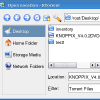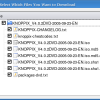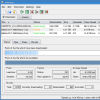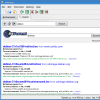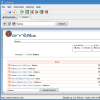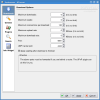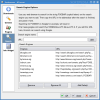I think that everybody heard about torrents. Anyway, I feel obliged to explain what this is. BitTorrent is a protocol for distributing files. It identifies content by URL and is designed to integrate seamlessly with the web. Its advantage over plain HTTP is that when multiple downloads of the same file happen in the same time, the downloaders upload to each other, thus making it possible for the file source to support very large numbers of downloaders with only a modest increase in its load. In this way, you contribute with bandwidth every time you download a file, making it less expensive for the publisher of that file because of the decrease in the costs required for bandwidth. To be able to download files from torrents you will need a client that is able to do it. There are notable differences between different BitTorrent clients and is important to find one that fits your needs. KTorent is one of the best clients for Linux and will be the subject of this review.
What can KTorrent do for me?
The most important thing is that it can download files, using the BitTorrent protocol. But this isn't enough, because for this purpose we have the classical BitTorrent client. Thank God this one does much more.
It has a very nice interface with an increased functionality. The application doesn't close when you close the main window and instead it stays minimized, displaying an icon which supports tooltips with information about the speed and size of download and upload. To start downloading, you can both paste the URL of the torrent or open the torrent file. When the download starts you are asked where it should download the file. This can be avoided by setting a default download directory. A torrent file can also be configured in such way to download a directory that contains more than one file. When this situation is encountered, KTorrent asks you which files should be downloaded. Sometimes this is useful. For example, when you are downloading a distribution and you don't need the sources which are on 3 CDs this can prove to be very useful.
KTorrent displays in the upper part of its window a list of files and individual information for each one regarding the size, the speed, the progress, the time left and the number of pears to which the client is connected. A little lower you can see four tabs.
The status tab shows some additional information regarding the selected file and also something similar to progress bars that shows the available chunks and the downloaded chunks. Chunks are actually segments of the files you download, which are split this way by the protocol. Lower in the window is displayed additional information about chunks.
The second tab is a list of files that regard the selected torrent. I like the fact that files can be removed from the download list and selected back for download. This also sort of allows you to download them in a certain order or upload only specific files.
The third tab displays the pears. In this list are available the IP address, the client, speed of download an upload, and some other stuff. If you weren't able to do anything here this would have been absolutely useless info. Even though, you can ban any pear with just a click a mouse, I don't see a real reason for doing that.
The last tab is the one that shows a list of the chunks you are downloading. The truth is that its practical use is inexistent and for this reason you can't use it in any way, but at least it is a nice display of some extra information. Fortunately for those who are all about usability, the last two tabs can be removed from Info Widget, which is located in the Preferences window.
The best thing I like about Ktorrent is that it can perform searches on several torrent search engines and you can even add some of your own. I particularly like this one because I was able to find almost anything using this feature. Now I don't have to waste precious time going through several websites.
KTorrent is expandable using plugins. I like programs that support plugins because you can extend functionality to fit your needs without making the software too heavy. Some plugins can add compatibility with UPnP devices or an IP blocking filter. Another one shows the log of the program in the main window. Most users don't need them and because of that they are disabled by default.
From the preferences window you can set limitations for upload and download speed and also for the maximum number of downloads. When you are behind NAT (have an IP like 10.x.x.x, 172.16.x.x or 192.168.x.x) it is recommended to set ports so that they can be forwarded. In KTorrent you can set these ports. Ask the network administrator more about this because it is sensitive stuff. If you are making the transition from another client you should know that another plugin can be used to import partially downloaded files.
The Good
I especially like the search function. Personally I find it very useful. I also like the interface, it is very nicely optimized. Developers did a good job.
The Bad
I miss the possibility to schedule a download. Sometimes I want to download a big and not so important file late at night so that my bandwidth doesn't have to suffer.
The Truth
The truth is that out there is also Azureus, another BitTorrent client which is very good as well, but it is written in Java and if you don't have Java it simply doesn't work. At the moment, I find KTorrent the best client for Linux.
Check out the screenshots below.
 14 DAY TRIAL //
14 DAY TRIAL // 